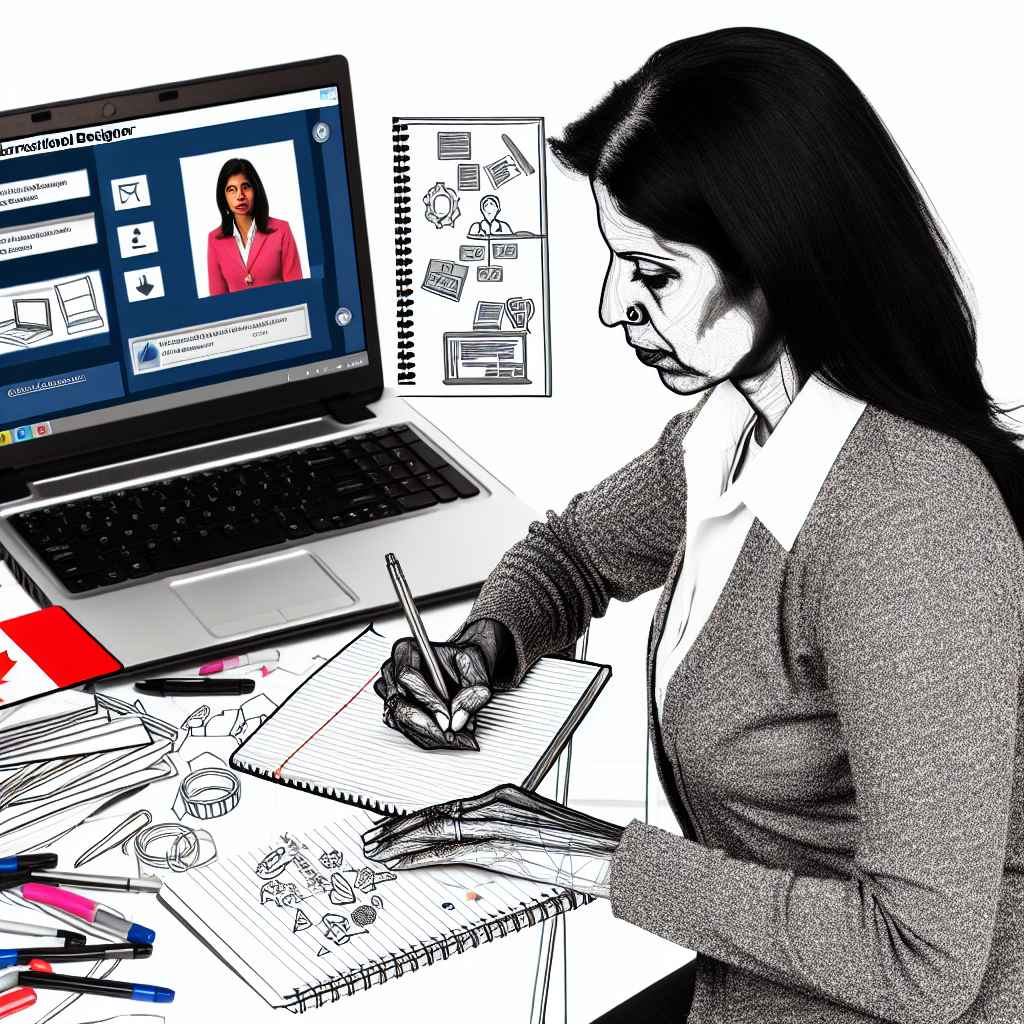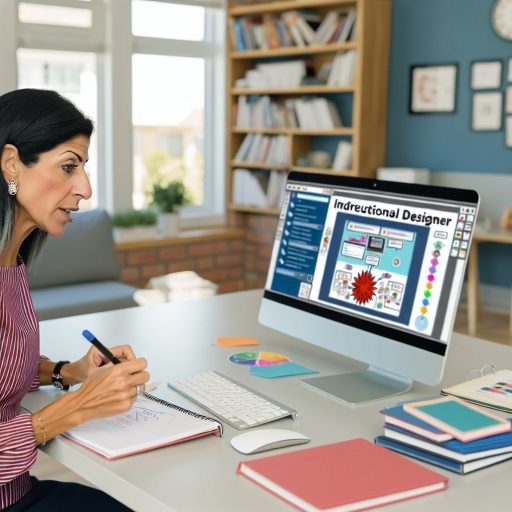Understanding the Role of an Instructional Designer
Overview of Instructional Design
Instructional design focuses on creating effective learning experiences.
Designers use systematic approaches to develop educational materials.
They consider learners’ needs and contexts in their work.
Additionally, they employ various media and technology to improve learning.
Key Responsibilities
Instructional designers analyze educational needs before creating content.
They develop learning objectives based on those needs.
Furthermore, they create and implement assessment strategies to evaluate learning outcomes.
After that, instructional designers revise materials based on feedback and effectiveness.
Collaboration with Stakeholders
Effective instructional design requires collaboration with various stakeholders.
Designers often work with subject matter experts to ensure content accuracy.
They also liaise with educators to align materials with curricular goals.
Moreover, feedback from learners informs adjustments to instructional strategies.
Skills and Competencies
Successful instructional designers possess strong analytical skills.
They have proficiency in design and multimedia software.
Additionally, excellent communication skills enhance their ability to collaborate.
They stay current with educational technologies and methodologies.
Application of Learning Theories
Instructional designers apply various learning theories in their approaches.
Behaviorism, cognitivism, and constructivism influence their design choices.
Understanding these theories helps them create engaging and effective learning environments.
For instance, they might use reinforcement strategies based on behaviorist principles.
Key Skills Required for Instructional Design
Understanding Learning Theories
Instructional designers must grasp various learning theories.
These theories guide them in creating effective educational experiences.
Familiarity with models like constructivism is essential.
This knowledge enhances their approach to course design.
Technical Proficiency
Technical skills are vital for modern instructional designers.
Unlock Your Career Potential
Visualize a clear path to success with our tailored Career Consulting service. Personalized insights in just 1-3 days.
Get StartedThey should be proficient in various authoring tools.
Tools like Articulate Storyline and Adobe Captivate are commonly used.
Moreover, understanding Learning Management Systems (LMS) is crucial.
Strong Communication Skills
Effective communication is a cornerstone of instructional design.
Designers must collaborate with subject matter experts.
They also need to convey complex ideas simply.
Being able to create clear instructional materials is necessary.
Project Management Abilities
Instructional designers should have solid project management skills.
They often juggle multiple projects simultaneously.
Effective planning helps ensure timely delivery of course materials.
Using project management tools can streamline their workflow.
Assessment and Evaluation Techniques
Designers must include assessment methods in their work.
These methods help measure the effectiveness of the instruction.
Creating both formative and summative assessments is important.
Continuous evaluation improves instructional design quality.
Creativity and Innovation
Creativity plays a significant role in instructional design.
Designers should craft engaging and interactive learning experiences.
They need to think outside the box to problem-solve effectively.
Innovative approaches enhance learner engagement and retention.
The Importance of Learning Theories in Instructional Design
Foundation of Effective Learning
Learning theories provide a solid foundation for instructional design.
They guide the selection of methods and materials.
Moreover, these theories help instructional designers understand how learners acquire knowledge.
Promoting Learner Engagement
Understanding different learning theories fosters learner engagement.
Instructional designers can create more interactive and appealing content.
For instance, applying constructivist theories encourages learners to participate actively.
Enhancing Learning Outcomes
Employing appropriate learning theories can significantly boost learning outcomes.
When designers align instruction with learner needs, comprehension improves.
Furthermore, effective strategies enhance retention and application of knowledge.
Adapting to Diverse Learning Styles
Learning theories allow designers to cater to diverse learning styles.
Different learners process information uniquely, and flexibility is key.
By considering these variations, designers can create inclusive and effective learning environments.
Continuous Improvement and Evaluation
Finally, learning theories support continuous improvement in instructional design.
They provide frameworks for evaluating the effectiveness of learning experiences.
Regular assessments lead to informed adjustments and enhancements in design.
Learn More: How Career Coaches Help Canadians Navigate Job Market Changes
Developing Technical Proficiency with E-Learning Tools and Software
Importance of Technical Skills
Technical skills are essential for instructional designers.
They enhance the ability to create effective learning experiences.
Moreover, these skills help in selecting suitable tools for projects.
Key E-Learning Tools
Familiarity with various e-learning tools is crucial.
Common tools include Articulate Storyline, Adobe Captivate, and Camtasia.
Additionally, designers should explore LMS platforms like Moodle and Blackboard.
Developing Software Proficiency
Proficiency in software comes from practice and continuous learning.
Join webinars and workshops to enhance your skills consistently.
Additionally, consider online courses tailored for specific tools.
Staying Updated with Industry Trends
The e-learning landscape evolves rapidly.
Staying informed about new tools and best practices is vital.
Follow industry blogs and participate in professional communities.
Hands-On Experience
Hands-on experience reinforces learning and skill development.
Engage in personal projects to experiment with new tools.
Collaborate with peers to gain insights from their experiences.
Creating a Portfolio
A strong portfolio showcases your technical skills.
Include diverse projects that highlight your proficiency with different tools.
Regularly update your portfolio to reflect your latest work.
Emphasizing User Experience
Understanding user experience (UX) enhances design quality.
Incorporate UX principles into your design process.
Regularly seek feedback to improve usability and effectiveness.
Learn More: How Instructional Designers Improve Corporate Training Programs
Creating Effective Assessments and Evaluation Strategies
Importance of Assessment in Instructional Design
Assessments play a crucial role in instructional design.
They measure learners’ understanding and skill acquisition.
In addition, effective assessments guide future instruction.
They can identify areas for improvement.
Moreover, assessments validate the effectiveness of the educational program.
Types of Assessments
Different types of assessments serve unique purposes.
Formative assessments provide ongoing feedback during the learning process.
These assessments help adjust teaching strategies.
Summative assessments evaluate learning at the end of a course.
They measure cumulative knowledge and skills.
Additionally, diagnostic assessments identify learners’ strengths and weaknesses.
Creating Effective Assessments
Clearly define the learning objectives before designing assessments.
Align assessments with course goals for relevance.
Incorporate a variety of assessment formats to engage learners.
Consider using multiple-choice questions, essays, and projects.
Moreover, ensure assessments are fair and unbiased.
Utilizing Technology in Assessments
Technology can enhance assessment delivery and analysis.
Use online quizzes and learning management systems for convenience.
Furthermore, digital tools can provide immediate feedback to learners.
Analytics can help track student progress over time.
Evaluating Assessment Effectiveness
Regularly evaluate the effectiveness of assessments.
Gather feedback from learners about the assessment process.
Assess whether the assessments meet the intended learning outcomes.
Adjust assessments based on analysis and learner input.
Furthermore, continuous improvement enhances overall instructional quality.
You Might Also Like: Early Childhood Education and Mental Health Awareness

Utilizing Multimedia Elements to Enhance Learning Experience
Understanding Multimedia in Learning
Multimedia incorporates various forms of content delivery in educational settings.
It includes text, audio, images, animations, and video elements.
This combination fosters diverse learning styles and engages learners effectively.
Benefits of Multimedia Elements
Incorporating multimedia can significantly enhance learning outcomes.
Firstly, it improves information retention among learners.
This occurs because different types of content appeal to various senses.
Secondly, multimedia can make complex concepts easier to grasp.
Visual aids can simplify abstract ideas and reinforce understanding.
Choosing the Right Multimedia Tools
Selecting appropriate tools is crucial for effective multimedia integration.
Consider the target audience and learning objectives when making a choice.
Popular tools include video production software, audio editing programs, and animation platforms.
These tools can create engaging content tailored to specific learning needs.
Designing with Accessibility in Mind
Accessibility ensures that all learners can benefit from multimedia content.
Use subtitles, captions, and descriptive audio for audio-visual materials.
Furthermore, consider color contrast and font size for visual elements.
Employing accessibility standards improves the learning experience for everyone.
Evaluating Multimedia Effectiveness
Regular assessment of multimedia elements is essential for continued improvement.
Gather feedback from learners to understand their experiences and challenges.
Adjust content based on this feedback to increase its effectiveness.
Additionally, utilize analytics tools to measure engagement and comprehension.
Discover More: Essential Certifications for Canadian Early Childhood Educators
Implementing Best Practices for User-Centered Design
Understanding User Needs
Identifying user needs is the first step in user-centered design.
Effective designers conduct interviews with potential users.
They also distribute surveys to gather broader insights.
Additionally, analyzing user behavior through observation proves beneficial.
Creating User Personas
User personas represent the target audience for the design project.
Each persona should include demographic information and lifestyle details.
Designers use these personas to tailor their content and interfaces.
Incorporating real user quotes enhances the authenticity of personas.
Prototyping and Iteration
Prototyping allows designers to test their ideas early in the design process.
Using wireframes helps illustrate the user interface layout.
Iteration is crucial; designers must refine prototypes based on user feedback.
Regularly revisiting prototypes ensures alignment with user needs.
Usability Testing
Conducting usability tests identifies areas for improvement in the design.
Observing users interact with the prototype reveals usability issues.
After testing, designers analyze the feedback for actionable insights.
They then implement changes to enhance user experience.
Accessibility Considerations
Designers must prioritize accessibility for all users.
Applying accessibility standards ensures inclusivity in design.
Considerations include color contrast and text legibility.
Designing for assistive technologies is also essential.
Continuous Feedback Loop
Creating a culture of feedback helps improve designs over time.
Soliciting feedback from peers and users keeps the design relevant.
Regular updates based on user needs foster a successful design solution.
This approach evolves the design to match changing user expectations.
Staying Current with Trends and Innovations in Educational Technology
The Rapid Pace of Change
Educational technology evolves at an astonishing rate.
Instructional designers must remain aware of these changes.
This awareness allows them to enhance learning experiences.
For example, new tools emerge frequently.
Keeping up is essential for creating effective training materials.
Leveraging Online Resources
Numerous online resources can help designers stay informed.
These include webinars, blogs, and professional organizations.
Platforms like LinkedIn Learning offer valuable courses.
Moreover, joining communities can foster collaboration.
Designers gain insights from peers and experts alike.
Attending Conferences and Workshops
Conferences provide excellent networking opportunities.
They allow designers to learn directly from industry leaders.
Workshops offer hands-on experiences with new technologies.
Attending both events enhances professional development.
Additionally, these gatherings inspire innovative ideas.
Staying Informed Through Research
Regularly reviewing academic literature keeps designers engaged.
Research provides insights into effective practices and methods.
Following key journals can foster ongoing learning.
This focus on evidence-based strategies benefits all learners.
Ultimately, staying informed drives continuous improvement.
Adapting to Learner Needs
Understanding diverse learner needs is crucial.
Technology should enhance accessibility and engagement.
As trends shift, so do the requirements of learners.
Instructional designers must be flexible and responsive.
Feedback from users helps refine and improve designs.
Exploring Emerging Technologies
Emerging technologies offer exciting new possibilities.
Augmented and virtual reality can transform learning experiences.
Artificial intelligence enables personalized learning paths.
Exploring these technologies opens up new avenues.
Staying curious about innovations creates opportunities for growth.
Additional Resources
The 28 Best Instructional Design Certificate Programs in 2025 …
Master’s in Learning Design and Technology – Purdue University …




